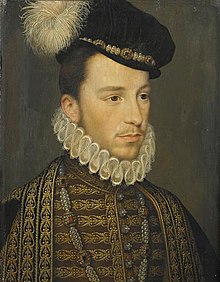This article needs additional citations for verification. (April 2016) |

Les Mignons (from mignon, French for "the darlings" or "the dainty ones") was a term used by polemicists in the contentious atmosphere of the French Wars of Religion and taken up by the people of Paris, to designate the favourites of Henry III of France, from his return from Poland to reign in France in 1574, to his assassination in 1589, a disastrous end to which the perception of effeminate weakness contributed.[1] The mignons were frivolous and fashionable young men, to whom public malignity attributed heterodox sexuality, rumors that some historians have found to be a factor in the disintegration of the late Valois monarchy.
- ^ Katherine B. Crawford, "Love, Sodomy, and Scandal: Controlling the Sexual Reputation of Henry III", Journal of the History of Sexuality 12.4 (October 2003:513–542.